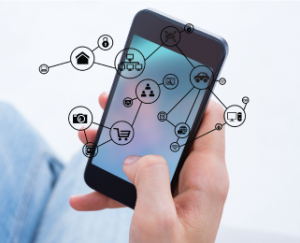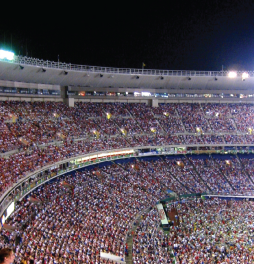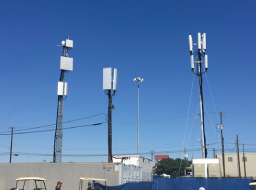Immaculate Cellular Reception: How Cell Phones Work at the Big Game


The Super Bowl LI fans streaming into NRG Stadium in Space City expect to witness a game-winning touchdown that will go viral. However, seeing it once won’t be good enough – not in this retweet world. If you turn back the calendar to July 1969, there was a different type of touchdown trending. The brains at mission control in Houston’s Johnson Space Center conversed with men on the moon nearly 239,000 miles away via a prehistoric wireless system. According to NASA, half a billion people huddled around television sets to watch a grainy live stream video of the space travelers walk on the lunar surface as if it was an end zone. They weren’t just pioneers in space exploration; they were perhaps the first to engage in genuine social media.

Not much has changed since then about a person’s innate desire to chat and share an experience while at a really cool place. And humans, especially cheering Falcons and Patriots fans on February 5th, will share nearly 20 Terabytes of Snapchats, Tweets, Instagram images, Facebook posts, and texts before, during, and after the Big Game.
HO-HUM. ANOTHER RECORD DAY FOR DATA USAGE.

Tethered to their wireless devices, more than 72,000 fans inside NRG Stadium, along with several thousand enthusiastic tailgaters around the venue, are expected to surpass the nearly history-making 9 terabytes of cellular data consumed at the 2016 Super Bowl on the Levi Stadium Distributed Antenna System. They devoured another 10.1 terabytes of data while using the free stadium WIFI network. To satisfy the communication needs of this magnitude, the nation’s four major wireless carriers have been dissecting digital data since Broncos coach Kubiak was showering in Gatorade.
Before you get too excited about data use records being broken year after year at large sporting events, remember that it takes both a strong network and insatiable demand to set the record. As manufacturers continue to make dramatic advancements in their devices and wireless companies work feverishly to increase network capacity, the customer feels more empowered and demands greater amounts of data at events like these. And the nation’s carriers have no choice but to provide lightning-fast networks that will enhance the user’s social media experience. This vicious cycle will continue to generate new data records year after year which the wireless companies will not hesitate to crow about.
FANS EXPECT FAST, SEAMLESS CONNECTIVITY.
WIRELESS CARRIERS MAKE SURE IT IS AVAILABLE.
Why be at the most coveted sporting event of the year if you can’t remind people that you are there? It’s a high-stakes day not just for the referees making the calls; if the carriers fail to transmit selfies, videos, Facebook likes, and Tweets faster than the speed of light, the natives will grow restless. Not to mention Facebook Live and other live video feeds, the gargantuan data-grabbers. This could translate into a major marketing blunder, not only in the eyes of the customers but also their competitors. For them, the data relay race on Super Bowl Sunday is their wireless Super Bowl and they don’t want to be forced into taking a defensive position.

So how do the wireless carrier masterminds orchestrate this stellar technological achievement without a hitch? Collaboration, teamwork, along with lots of data and mega bucks. Wireless carriers like AT&T, Sprint, T-Mobile, and Verizon have each invested anywhere from $10 million to $100 million to improve their cellular infrastructure. From a revenue perspective, it may not make sense to invest this much capital into their networks for this single event – but they will. Even if they could opt-out, the providers place immense value on their customers’ loyalty; the elite big four dread being roasted on social media for days if disgruntled fans complain of stuttering videos and mention them by name. So to prevent self-inflicted PR damage, the carriers will be on site to protect their brand and ensure customers are connected and content.
HOW THEY DO IT
For over a year, the City of Houston has been responding to requests and issuing building permits to the carriers authorizing the installation of hundreds of large and small cell sites, cell towers, temporary cell on wheels, distributed antenna systems (DAS) antennas and antenna equipment in preauthorized locations. Each site type has a very specific objective in the network. If all goes as planned, they will perform flawlessly, much to the delight of fans, carriers, and citizens of the host city. How does it all work? The image below shows how these various components interact to form what the industry refers to as a heterogeneous network or Het-Net.

To accommodate the data demands of outdoor users, a complex interwoven network of large (macrocell) and smaller cellular network sites (small cells and DAS) have been strategically placed along the routes leading to NRG. They have also been staged at various other venues in Greater Houston in anticipation of thousands who will be anxious to join friends and family on social media. To guarantee their jubilation won’t be short-lived, carriers have rounded up just under 100 COWS, cell sites on wheels. These trailer trucks or mobile cell sites are equipped with powerful antennas and radio transceivers to generate extra juice for the cheering fans. The data-hungry partiers who thirst for greater capacity may never even notice the massive, elaborate infrastructure that was designed especially for them. However, they will appreciate it, nonetheless. After the event, the wireless companies can simply pack up this extra capacity and move it to the next event.
As motorists approach the stadium, they are in a steady lane of traffic on highways and roadways to the big event. Along their route, macrocells on towers, rooftops, and other structures are the first to transmit and receive cell phone signals to and from mobile phones. And inevitably the traffic gets congested, which naturally means more people are in the same concentrated area using their wireless devices. This is a call to action for small cell sites; they are deployed to “densify” or increase the capacity of the overall network. A small cell is an individual cell site that is smaller in size, power and coverage radius. The macrocells, small cells, and COWS are part of an incredibly smart network; engineers are able to adjust the capacity according to the density of users. With a click of a mouse, they can redirect multiple smart antennas on multiple sites to refocus on areas of congestion.

As the countdown clock ticks closer to kick-off, festive fans begin to arrive at the stadium. Some may congregate at a pregame event or join tailgaters. Still, others may gather with friends and family at a hotel or nearby park. Outside the stadium, wireless carriers have installed a “Het-Net” of rooftop and tower macrocells, small cells, COWS, and powerful Outdoor Distributed Antenna Systems. This infrastructure will provide the capacity boost for the fans. Wherever the fans are, the system must be ready and able to handle the migration and respond with precise accuracy to any media request they are making. By layering small cells and DAS nodes under the macrocells, the wireless carriers make sure that you have coverage wherever you go and capacity whenever you need it.

A BIRD’S EYE VIEW OF THE CELLULAR INFRASTRUCTURE NEAR THE STADIUM
So how and where does this infrastructure get deployed? Steel in the Air, Inc. examined its proprietary cell tower/infrastructure database to determine the amount and location of wireless infrastructure in the area of NRG Stadium.
Below is a map showing the wireless infrastructure.

 If you examine the map, you will see that the towers and rooftop sites are taller and farther apart and provide wider area coverage over the surrounding areas. Underlying the towers and rooftop macrocells are Distributed Antenna System nodes and small cells (both of which are labeled as small cells for simplicity). While this map only includes the area surrounding NRG stadium, similar tower and small cell development permeates all of Houston. To the right is a chart showing how many cell sites are within 2 miles of the Stadium and our estimate of all sites in the Houston metropolitan area.
If you examine the map, you will see that the towers and rooftop sites are taller and farther apart and provide wider area coverage over the surrounding areas. Underlying the towers and rooftop macrocells are Distributed Antenna System nodes and small cells (both of which are labeled as small cells for simplicity). While this map only includes the area surrounding NRG stadium, similar tower and small cell development permeates all of Houston. To the right is a chart showing how many cell sites are within 2 miles of the Stadium and our estimate of all sites in the Houston metropolitan area.
IT DOESN’T END ONCE YOU ENTER THE STADIUM
Outdoors, mobile devices are connected to the cellular network. But once inside the stadium, it’s a whole new ballgame as your device connects to the stadium’s WiFi. And this is where the focus has been intensified. Stadiums built in recent years are constructed with reinforced concrete columns, tons of steel and energy-efficient windows. They, like the 1.9 million square foot NRG Stadium, are nearly impenetrable fortresses daring any wireless signal to enter. However, the nation’s wireless providers are up to the challenge of providing enough capacity to appease approximately 100,000 individuals. Getting enough fiber and bandwidth past all the barriers to end users in the centermost parts of the venue presents an even bigger obstacle. It requires installing nearly 1,300 access points throughout the venue, even placing them underneath seats. That is one access point for every 61 one fans expected to attend the game. Saturating the stadium with WiFi should prevent guests from enduring the frustration of being in a wireless dead zone. For the stadium owner, it gives them the ability to provide catered information and services to their attendees. More importantly to the wireless carriers, it saves them from having to build out a more robust (read expensive) Distributed Antenna System. In most cases, WiFi is cheaper to deploy than cellular connectivity.

The providers have already spent lavish amounts of money to obtain access – simply for the unique right to be there. Wireless Week states that Verizon, the official wireless provider of the Houston Texans and NRG’s major tenant, has invested $40 million on its Distributed Antenna System.
The return on the investment? According to Verizon, fans will enjoy a capacity increase of 450%. {This link has a nice photo.} AT&T matched that amount, and T-Mobile and Sprint also made significant investments to boost LTE capacity. Their goal is to provide seamless WiFi connectivity for the users, so they won’t use their normal data plans. Otherwise, there would be a data overload.
According to GeekWire, users at the golden anniversary Super Bowl last year consumed 63% more data over the WiFi network than at the prior year. And since records are made to be broken, the stats for 2017 may well eclipse Levi’s Stadium’s 10 TB record.
GAME PLAN
TO HANDLE THE PEAKS AND VALLEYS
Meanwhile, at the command center, hundreds of radio frequency engineers and technicians from all four wireless carriers and from the stadiums WiFi vendor will be monitoring network performance. Armed with data and experience, they can project the peak and valley data usage locations in and around NRG. And they dare not forget that many people will bring more than one device. Even before the coin toss, the nation’s major providers will have their eagle-eyes trained on computer screens. Data requests will be rising, as well as the rhythm of their hearts. Everything in and around this day is built and designed for peak usage; it is the cornerstone. It is those critical levels when a network is most vulnerable. The first moonwalker, Neil Armstrong, reflecting back on the lunar landing remarked,”…there were just a thousand things to worry about.” The carriers know the feeling.
There’s nothing like a touchdown to bring fans to their feet. Simultaneously, they are seizing data as fast as they can to capture the event and send their Oscar-worthy video to family and friends. As they post either their joy or disgust on Facebook, watch an instant replay on their device, or snap celebratory selfies, those at the command center plan to keep boosting network performance. The halftime festivities are also times of intense peaks. If fans aren’t watching the activities on the field, they are active on social media, either in their seats or as they wait in a long line for refreshments of relief.
The carriers will start to breathe a collective sigh of relief after the champions hoist the Vince Lombardi Trophy, but their work isn’t quite finished. Departing fans will still be active on social media. Geekwire stated that at the 2016 Super Bowl, Facebook was the most active social app. And to think that when Houston last hosted the Super Bowl in 2004, Facebook was still three days away from being launched. And Twitter didn’t earn its wings until 2006.

One major, continuous event during the week-long Super Bowl festivities is the NFL Experience. This massive interactive display provided by the National Football League is located a few miles away at the cavernous George R. Brown Convention Center. One of the main attractions will be personalized digital photos. Again, the four major providers have revved up WiFi’s infrastructure to provide enough capacity for thousands of attendees to share their adventures on social media. The NFL Experience is designed to allow fans to enjoy an exhilarating atmosphere with others who share the passion for football. They can even be dazzled by viewing the prized Lombardi Trophy on display. Those who lack a ticket to the Super Bowl, may use their imaginations to transport them to a front row seat inside NRG.
Once the NFL has exited NRG stage left, a steady stream of other events will converge on the stadium. So the millions of dollars invested by the providers will benefit the millions who will visit the venue and the surrounding area shortly. In fact, the Houston Livestock Show & Rodeo will begin setting up for the world’s largest rodeo event, running March 7–26. The average daily attendance is 2 million, all of whom will salute Verizon, T-Mobile, Sprint and AT&T for enriching their experiences, which they will no doubt, share on social media.













3 thoughts on “Immaculate Cellular Reception: How Cell Phones Work at the Big Game”
Ken, cohesive even understandable to many of us cell site LLs. The work your team did in preparing / presenting this is laudable
Thank you Paul. I appreciate the comment.
Have you considered tethered drones as a COW?